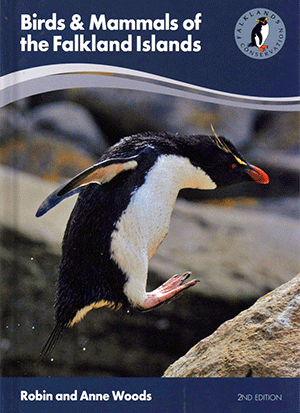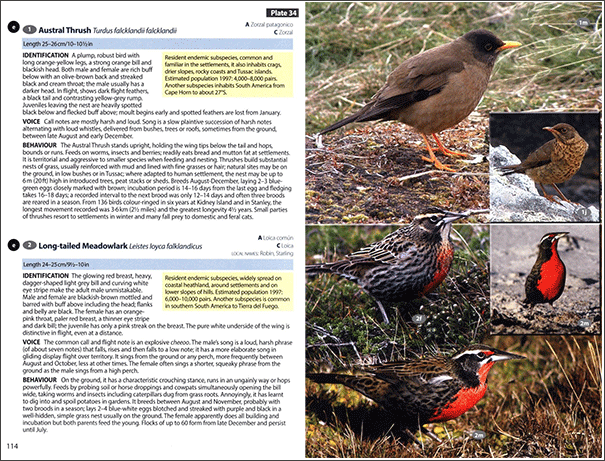Birds & Mammals of the Falkland Islands
2nd Edition

I can see 50 species of birds in a morning on my home patch in Somerset. So why on earth would I travel 8,000 miles to see fewer than that in a whole week? Take a look at this book and you’ll soon see why.
The Falkland Islands may not have all that many resident birds (though it does have a national list of well over 200 species), but what birds they are! From the stately King Penguin at the front of the book, to the attractive White-bridled Finch at the back, this is all about quality. There are five species of penguin – more than you can see virtually anywhere in the world – plus Black-browed Albatross, a fine selection of waders and waterfowl, and three endemics: the Falkland Steamer-duck, Cobb’s Wren and the Tussacbird, recently split from the Blackish Cinclodes.
The Falkland Islands are also one of the best places in the world to see marine mammals. Roughly 25 species of cetacean – whales, dolphins and porpoises – have been recorded there, although only four are regular: the Orca or Killer Whale, Sei Whale, and Peale’s and Commerson’s Dolphins. However, there is always a chance of picking up something more unusual, especially on boat trips offshore.
There are also three kinds of seal and sealion: the commonest being the Southern Sea Lion, which regularly rests on the jetty at the island’s capital Stanley; along with the South American Fur Seal, found mainly on the outermost islands; and the Southern Elephant Seal, the world’s largest member of its tribe. The huge and impressive males can be seen loafing on the shores of many of the outer islands, occasionally rousing themselves to fight a rival, while uttering deep, roaring calls.
Who better to guide the visitor wanting to see these very special birds and mammals than Robin Woods, who has spent his life studying the wildlife of this South Atlantic archipelago. Together with his wife Anne, and photographer and expert birder Alan Henry, he has fully revised this guide (which was originally published in 2006) for Falklands Conservation.

The format is simple, clear and comprehensive, as to be expected from the excellent WildGuides. A thorough and detailed introduction covers all the background information, which is so essential when visiting a new and unfamiliar location. There are clear and detailed sections on Topography, Climate, Vegetation, Predation and Environmental Change, followed by a plug for the work of the charity Falklands Conservation, which does such a fantastic job protecting the islands’ wildlife, and played an important role in getting this book updated and republished.
Birders will also enjoy perusing the Checklist of Falkland Islands Birds, but be aware that three-quarters of those included are either scarce visitors or rare vagrants. The page of more than 50 ‘Unconfirmed Species’ may also whet the appetite of any rarity-hunter, keen to add a new species to the islands’ list. With so few local observers, and so much territory to cover, visiting birders do have a very real chance of doing so.
But birding – and mammal-watching – in and around the Falklands is more about the overall experience than simply ticking off new species. The main section of this guide reflects this: page after page of mouth-watering photos, illustrating accounts of the birds and marine mammals that every visitor wants to see.
King, Gentoo, Southern Rockhopper, Macaroni and Magellanic Penguins; a host of seabirds, including the Black-browed Albatrosses that nest here in their hundreds of thousands; the local race of the White-tufted Grebe, which is so much bigger than its counterpart on the South American mainland, and it is surely another candidate to be split; and the quirkiest Falklands bird of all, the Striated Caracara, aka ‘Johnny Rook’, a raptor so tame and curious that I had to back away when photographing it.
As the pictures in this guide show, you won’t have any problem getting close-ups of most of the birds here. And not just the usual suspects: the islands may only have ten species of songbirds (including the self-introduced House Sparrow, which hopped off a whaling ship a hundred years ago this year), but most of them (with the odd exception of the sparrow) are so obliging they more or less pose for photographs.
The text of the guide is a masterful example of how to condense a lot of key information into a small space: not just the key identification points, but also notes on status and behaviour, the name used for the species in both Argentina and Chile and, where appropriate, the local name. I found this very useful, as the islanders tend to use these freely: my favourites were ‘Robin’ and ‘Military Starling’, both used for the handsome black-and-red Long-tailed Meadowlark.
It’s worth noting that Birds & Mammals of the Falkland Islands isn’t the only work of note by Robin Woods. He has also compiled the 25th in the series of authoritative BOC Checklists, The Birds of the Falkland Islands (2017). ‘Checklist’ is a bit of a misnomer: this is a thorough survey of the islands’ avifauna over time, fully referenced and incredibly comprehensive; the ideal companion to the pocket-sized field guide under review.
The Falkland Islands may not appeal to the avid lister, desperate to add dozens of new species at every destination they visit; yet its combination of avian spectacle and a handful of birds found nowhere else in the world does make it, for me, a must-visit site. Whether you are on a cruise ship stopping off in the Falklands for just a day or two, or on a longer trip, these two books, compiled by the acknowledged expert on this far-flung location, are simply invaluable.
Stephen Moss
15 February 2019
Stephen Moss travelled courtesy of the Falkland Islands Tourist Board.
Falklands Conservation works to conserve the wildlife in the Falkland Islands for future generations. To join Falklands Conservation, adopt a penguin, or leave a legacy go to: www.falklandsconservation.com
Share this review




